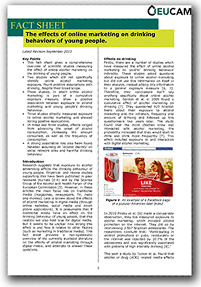
This review of currently available scientific literature shows exposure to online alcohol marketing leads to advancing the onset of alcohol consumption, increasing the amount consumed, as well as the frequency of consumption.
Gap in the literature
It has been well established by various studies that exposure to alcohol advertising affects the drinking behaviour of young people. Empirical- and review studies supporting this have been published in peer reviewed journals [1-4] and by the Science Group of the Alcohol and Health Forum of the European Commission [5]. However, there appears to be a gap in the literature and common knowledge when it comes to the specific measured effects of online alcohol marketing. To fill this gap, EUCAM initiated a non-systematic literature review which found 10 studies that in one way or another measured the effects of exposure to digital or online alcohol marketing on the drinking behaviour of young people.
Main findings:
• Two studies which did not specifically identify online alcohol marketing exposure, found positive associations with drinking, despite their broad scope [6, 7].
• Three studies, in which online alcohol marketing is part of a cumulative exposure measure, show a positive association between exposure to alcohol marketing and young people’s drinking behaviour [8-10].
• Three studies directly measured exposure to online alcohol marketing and showed strong positive associations [11-13].
• In these last three studies, effects ranged from advancing the onset of alcohol consumption, increasing the amount consumed, as well as the frequency of consumption [11-13]. One study even suggests an association with binge drinking [13].
• One study found that the effect of online alcohol advertising was almost twice as strong as that of traditional marketing [11].
• It’s not just commercial advertising messages: In two studies a strong association has been found between young people explicitly presenting their selves as drinkers (assuming an ‘alcohol identity’) on social network sites and harmful drinking behaviour [14, 15].
• This last association exemplifies the problem of the lines being blurred between commercial advertising messages and user generated content on social media sites [14, 15].

